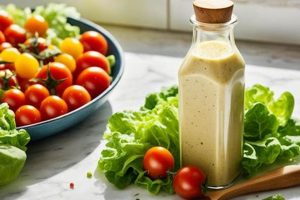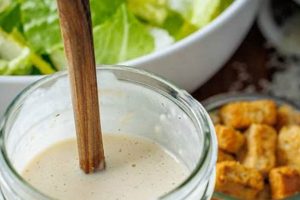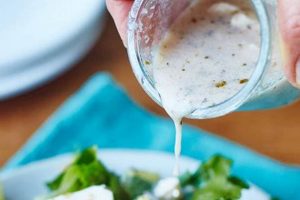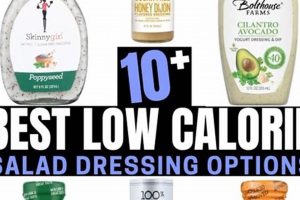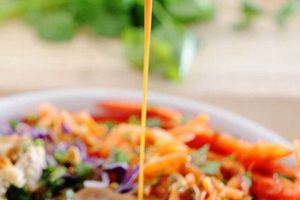Dressings for salads made without animal products encompass a wide variety of flavors and textures, utilizing ingredients like fruits, vegetables, nuts, seeds, herbs, spices, and various oils and vinegars. Examples include creamy avocado dressings, tangy citrus vinaigrettes, and rich tahini-based emulsions.
These culinary creations offer numerous advantages. They often contribute fewer saturated fats and cholesterol compared to traditional dairy-based options, aligning with health-conscious dietary choices. Furthermore, the reliance on plant-derived components promotes sustainability and reduces the environmental impact associated with animal agriculture. Historically, many cultures have utilized plant-based ingredients in their sauces and condiments, laying the groundwork for the diverse range of contemporary vegan salad dressings available today.
Exploration of specific ingredients, preparation techniques, flavor profiles, and nutritional aspects will further illuminate the versatility and appeal of incorporating non-dairy dressings into a balanced and flavorful diet.
Tips for Crafting Delicious Plant-Based Salad Dressings
Creating flavorful and healthful plant-based salad dressings can enhance any salad. These tips offer guidance for achieving optimal results.
Tip 1: Embrace Flavorful Oils. High-quality oils like extra virgin olive oil, avocado oil, or toasted sesame oil provide a foundation of flavor. Consider the oil’s inherent taste when pairing it with other ingredients.
Tip 2: Explore Acidity. Vinegars, citrus juices, or even fermented ingredients like kombucha contribute brightness and complexity. Experiment with different types to find complementary flavor profiles.
Tip 3: Harness the Power of Emulsifiers. Creamy textures can be achieved without dairy by utilizing ingredients like silken tofu, tahini, avocado, or soaked cashews. These help bind the oil and aqueous components together.
Tip 4: Seasoning is Key. Fresh herbs, spices, garlic, ginger, and nutritional yeast offer depth and complexity. Adjust seasonings to balance the flavors of other ingredients.
Tip 5: Utilize Sweeteners Sparingly. A touch of sweetness can balance acidity, but avoid overpowering the other flavors. Maple syrup, agave nectar, or dates can be used in moderation.
Tip 6: Texture Matters. Consider the desired consistency. Blend dressings until smooth for creamy results, or leave some texture for added interest.
Tip 7: Taste and Adjust. The most crucial step is tasting and adjusting seasonings as needed. Palates vary, so personalization is essential.
By following these tips, one can elevate salads with delicious and healthful plant-based dressings, offering both flavor and nutritional benefits.
Experimentation and creativity are encouraged to discover new flavor combinations and enhance culinary experiences.
1. Ingredients
Ingredient selection is paramount in crafting exceptional plant-based salad dressings. The quality and combination of components directly influence the final product’s flavor, texture, nutritional value, and overall appeal. A thorough understanding of core ingredient categories provides a foundation for recipe development and culinary exploration.
- Oils
Oils form the base of most dressings, contributing richness, texture, and flavor. Extra virgin olive oil offers robust fruitiness, while avocado oil provides a neutral backdrop for other ingredients. Consider flavor profiles when selecting oils, ensuring compatibility with other components. The oil’s quality significantly impacts the dressing’s overall health benefits.
- Acids
Acidity balances richness and adds brightness. Vinegar choices range from apple cider vinegar with its mild sweetness to balsamic vinegar with its complex tang. Citrus juices, like lemon or lime, provide a refreshing zest. Balancing acidity with other flavors prevents overpowering tartness.
- Emulsifiers
Emulsifiers create creamy textures and stabilize the mixture, preventing separation. Silken tofu, tahini, avocado, or soaked cashews blend seamlessly with other ingredients, providing body and creaminess without the use of dairy. The choice of emulsifier also contributes to the dressing’s nutritional profile.
- Flavor Enhancers
Flavor enhancers add depth and complexity. Fresh herbs, spices, garlic, ginger, nutritional yeast, mustard, maple syrup, and agave nectar elevate dressings beyond basic oil and vinegar combinations. Strategic use of these ingredients creates unique flavor profiles tailored to individual preferences.
Careful consideration of these ingredient categories and their interplay enables the creation of diverse and delicious plant-based salad dressings suitable for a wide range of culinary applications and dietary preferences. Harmonious combinations of oils, acids, emulsifiers, and flavor enhancers result in dressings that not only complement salads but also contribute to a balanced and flavorful diet.
2. Flavor Profiles
Flavor profiles play a crucial role in the creation of successful plant-based salad dressings. A well-balanced and intentional flavor profile elevates a simple salad into a culinary experience. Understanding the interplay of different taste components allows for the development of dressings that complement a wide range of ingredients and satisfy diverse palates.
- Sweet and Tangy
This classic combination offers a balance of sweetness and acidity. Examples include dressings featuring maple syrup or agave nectar combined with apple cider vinegar or lemon juice. These profiles pair well with salads containing fruits, nuts, and milder greens like spinach or butter lettuce. The sweetness complements the natural sugars in fruits, while the tangy notes cut through richness and add brightness.
- Savory and Earthy
Dressings emphasizing savory and earthy notes often incorporate ingredients like tahini, miso, nutritional yeast, or mushrooms. These profiles lend themselves to salads featuring roasted vegetables, grains, and heartier greens like kale or romaine. The umami notes of these ingredients add depth and complexity, creating a satisfying and grounding flavor experience.
- Spicy and Zesty
Dressings with a kick incorporate chili flakes, jalapeos, ginger, or other spices. These profiles add excitement to salads and pair well with ingredients like beans, corn, avocado, and robust greens. The heat contrasts with the other flavors in the salad, creating a dynamic and invigorating culinary experience.
- Creamy and Herbaceous
Creamy dressings often utilize avocado, cashew cream, or silken tofu as a base, providing a rich and luxurious texture. The addition of fresh herbs like dill, parsley, mint, or cilantro contributes brightness and complexity. These profiles complement salads featuring delicate greens, vegetables, and herbs, creating a refreshing and flavorful dish.
By understanding and utilizing these flavor profiles, one can create plant-based salad dressings that not only enhance the flavors of the salad ingredients but also offer a diverse range of taste experiences. Experimentation with different combinations of ingredients and flavor profiles allows for culinary creativity and personalized culinary creations.
3. Preparation Methods
Preparation methods significantly influence the texture, emulsion stability, and overall quality of plant-based salad dressings. Selecting the appropriate technique ensures the desired consistency and maximizes flavor development, creating dressings that enhance the culinary experience.
- Whisking
Whisking is ideal for vinaigrettes and dressings that do not require emulsification. This method combines oil and vinegar with seasonings, creating a light and airy texture. Whisking is a quick and simple technique suitable for dressings with minimal ingredients. The resulting texture offers a distinct contrast to creamy dressings.
- Blending
Blending creates smooth and creamy dressings by thoroughly incorporating emulsifiers like nuts, seeds, tofu, or avocado. High-speed blenders effectively break down these ingredients, resulting in a homogenous and stable emulsion. This method is ideal for dressings requiring a smooth, velvety texture.
- Mortar and Pestle
Using a mortar and pestle offers a traditional approach, allowing for precise control over ingredient breakdown. This method is particularly effective for creating dressings with coarsely ground spices or herbs, adding texture and depth of flavor. The manual grinding process releases aromatic compounds, enhancing the overall sensory experience.
- Shaking
Shaking is a convenient method for emulsifying dressings, particularly when using a jar or container with a tight-fitting lid. Vigorous shaking combines the ingredients and creates a temporary emulsion. This technique is suitable for dressings prepared just before serving, as the emulsion may separate over time.
The chosen preparation method directly impacts the final characteristics of the plant-based salad dressing. Selecting the appropriate technique, whether whisking, blending, using a mortar and pestle, or shaking, ensures the desired texture, flavor development, and emulsion stability. Understanding these techniques allows for customization and control over the final product, resulting in dressings that complement a variety of salads and culinary creations.
4. Nutritional Considerations
Nutritional considerations are integral to formulating healthful and beneficial plant-based salad dressings. Ingredient choices directly impact the nutritional profile of these dressings, influencing calorie content, fat composition, vitamin and mineral density, and overall health benefits. Careful selection of components allows for the creation of dressings that not only enhance flavor but also contribute to a balanced diet.
For example, opting for extra virgin olive oil over refined vegetable oils increases the monounsaturated fat content, providing heart-healthy benefits. Incorporating nutrient-rich ingredients like nuts, seeds, and avocados further enhances the nutritional value by contributing healthy fats, fiber, vitamins, and minerals. Conversely, minimizing added sugars, such as maple syrup or agave nectar, helps control calorie intake and maintain balanced blood sugar levels. Furthermore, using fresh herbs and spices instead of excessive salt reduces sodium content, promoting cardiovascular health. Understanding the nutritional impact of each ingredient empowers informed choices that align with individual dietary needs and health goals.
Prioritizing nutritional value in plant-based salad dressing recipes yields several advantages. Dressings rich in healthy fats, fiber, vitamins, and minerals contribute to satiety, promote digestive health, and support overall well-being. Conversely, minimizing less healthful components, such as saturated fats, added sugars, and excessive sodium, mitigates potential health risks. Therefore, a thorough understanding of nutritional considerations allows for the creation of dressings that not only taste delicious but also provide significant health benefits, supporting a balanced and nutritious diet.
5. Storage Techniques
Proper storage techniques are essential for maintaining the quality, flavor, and safety of plant-based salad dressings. Because these dressings often utilize fresh ingredients and lack the preservatives found in commercially produced counterparts, they are susceptible to spoilage and oxidation. Effective storage practices mitigate these risks, preserving the dressing’s desirable characteristics and maximizing shelf life. For example, dressings containing fresh herbs or avocado are particularly prone to browning and flavor degradation when exposed to air. Storing these dressings in airtight containers and refrigerating them promptly after preparation helps maintain their vibrant green color and fresh taste. Conversely, oil-based dressings without perishable ingredients may be stored at room temperature in a cool, dark place, although refrigeration further extends their shelf life.
Different storage methods yield varying outcomes regarding preservation and shelf life. Refrigeration significantly slows microbial growth and enzymatic activity, extending the usability of dressings containing fresh ingredients. Airtight containers minimize oxidation, preventing undesirable flavor changes and maintaining the integrity of oils and other susceptible components. Furthermore, avoiding temperature fluctuations helps preserve the dressing’s emulsion stability and prevent separation. For instance, repeatedly removing a refrigerated dressing from a cold environment and allowing it to warm to room temperature can destabilize the emulsion and lead to a less desirable texture. Therefore, understanding the impact of different storage methods allows for informed decisions that optimize preservation and maintain the dressing’s quality.
Effective storage practices directly impact the overall culinary experience. A properly stored dressing retains its intended flavor, texture, and appearance, enhancing the enjoyment of the salad. Conversely, improper storage can lead to off-flavors, textural changes, and even spoilage, diminishing the sensory appeal and potentially posing health risks. Therefore, implementing appropriate storage techniques is crucial for maximizing the quality, safety, and longevity of plant-based salad dressings, ensuring a consistently positive culinary experience.
6. Creative Variations
Creative variations within plant-based salad dressing recipes offer avenues for culinary exploration and personalized flavor experiences. Expanding beyond basic formulas allows for the development of unique dressings tailored to individual preferences and dietary needs. This exploration involves adapting core recipes, incorporating diverse ingredients, and experimenting with flavor combinations, ultimately enhancing the versatility and enjoyment of plant-based cuisine.
- Global Flavor Influences
Integrating global flavor profiles expands the range of possibilities. Drawing inspiration from diverse culinary traditions, such as incorporating miso paste for a Japanese-inspired dressing or using harissa paste for a North African twist, introduces unique flavor dimensions. Adapting traditional recipes with plant-based ingredients allows for the exploration of authentic flavors while adhering to dietary restrictions.
- Seasonal Ingredient Adaptations
Utilizing seasonal ingredients maximizes freshness and flavor while supporting local agriculture. Substituting in-season fruits, vegetables, and herbs allows for continuous variation throughout the year. For instance, a summer dressing might feature fresh berries and basil, while a fall version incorporates roasted squash and sage. This approach not only provides variety but also aligns with sustainable culinary practices.
- Texture Exploration
Texture plays a significant role in the overall sensory experience of a salad. Incorporating ingredients that provide textural contrast, such as toasted nuts, seeds, or chopped vegetables, adds complexity and interest. Experimenting with different preparation methods, such as coarsely chopping versus finely mincing, further influences the final texture. Balancing creamy, crunchy, and smooth elements enhances the overall enjoyment of the dish.
- Dietary Adaptations and Substitutions
Creative variations allow for customization to accommodate specific dietary needs. Substituting ingredients to address allergies or sensitivities expands accessibility. For example, using maple syrup in place of honey caters to vegan preferences, while utilizing gluten-free tamari instead of soy sauce addresses gluten intolerance. These adaptations ensure that individuals with dietary restrictions can enjoy flavorful and personalized plant-based dressings.
By embracing creative variations, individuals can transform basic plant-based salad dressing recipes into personalized culinary creations. Exploring global flavors, incorporating seasonal ingredients, experimenting with textures, and adapting recipes to suit dietary needs expands the possibilities of plant-based cuisine. This approach not only enhances flavor and enjoyment but also encourages culinary creativity and a deeper appreciation for the versatility of plant-based ingredients. The resulting dressings elevate salads from simple side dishes to culinary centerpieces.
7. Dietary Adaptations
Dietary adaptations play a crucial role in the formulation of plant-based salad dressings, expanding their accessibility and inclusivity. Addressing specific dietary needs, such as allergies, intolerances, and ethical choices, requires careful consideration of ingredient selection and recipe modification. Understanding the impact of various substitutions and omissions allows for the creation of dressings that cater to a wider range of individuals while maintaining flavor and functionality. For instance, individuals with soy allergies can replace soy sauce with coconut aminos or tamari, ensuring a similar umami profile without triggering allergic reactions. Similarly, gluten-free diets necessitate the use of gluten-free vinegars and avoiding thickeners containing wheat-based ingredients. Ethical considerations, such as veganism, require the exclusion of all animal products, including honey, which can be readily substituted with maple syrup or agave nectar.
Practical application of dietary adaptations involves careful recipe analysis and ingredient awareness. Recognizing potential allergens and understanding their substitutes empowers informed decision-making during recipe development and preparation. Cross-contamination risks necessitate vigilance in ingredient sourcing and preparation techniques. Dedicated equipment and utensils prevent accidental exposure to allergens, ensuring the safety of individuals with sensitivities. Clear labeling and communication of ingredient information are paramount, particularly in shared dining environments, enabling informed choices and mitigating potential health risks. Recipes designed with dietary adaptations in mind prioritize inclusivity, allowing individuals with diverse dietary needs to enjoy flavorful and safe plant-based salad dressings.
Successful integration of dietary adaptations requires a nuanced understanding of ingredient functionality and flavor profiles. Substitutions should not compromise the intended taste or texture of the dressing. Careful balancing of flavors and textures ensures that the adapted recipe remains palatable and enjoyable. Ingredient awareness extends beyond allergen avoidance; it encompasses understanding the nutritional impact of substitutions. Replacing refined sugars with natural sweeteners, for example, maintains flavor while minimizing added sugars. Therefore, successful dietary adaptations consider both culinary and nutritional implications, resulting in dressings that are both delicious and health-conscious, promoting inclusivity without compromising quality or flavor.
Frequently Asked Questions
This section addresses common inquiries regarding plant-based salad dressings, providing concise and informative responses to clarify potential uncertainties and misconceptions.
Question 1: How can creamy textures be achieved without dairy?
Creamy textures in plant-based dressings are achieved using ingredients like silken tofu, soaked cashews, avocado, or tahini. These ingredients, when blended, create smooth, emulsified dressings that mimic the richness of dairy-based counterparts.
Question 2: What are suitable oil alternatives for those avoiding olive oil?
Individuals avoiding olive oil can explore alternatives like avocado oil, grapeseed oil, or sunflower oil. Flavor profiles vary; selecting a neutral oil allows other ingredients to shine.
Question 3: How can added sugars be minimized while maintaining flavor balance?
Balancing acidity with sweetness is key. Instead of relying solely on added sugars, incorporate naturally sweet ingredients like dates or roasted carrots. A touch of acidity from vinegar or lemon juice can also balance flavors.
Question 4: What storage practices maximize the shelf life of homemade dressings?
Storing dressings in airtight containers in the refrigerator maximizes shelf life. Prompt refrigeration after preparation and minimizing exposure to air helps preserve flavor and prevent spoilage.
Question 5: How can one adapt recipes to accommodate specific dietary restrictions?
Dietary adaptations involve substituting ingredients. Maple syrup replaces honey for vegans. Gluten-free tamari substitutes for soy sauce. Awareness of allergen cross-contamination is crucial.
Question 6: Are plant-based dressings inherently healthier than traditional dressings?
Not all plant-based dressings are automatically healthier. While many offer benefits like reduced saturated fat, careful ingredient selection is essential. Minimizing added sugars and choosing healthful oils contributes to overall nutritional value.
Addressing these common questions empowers informed choices regarding ingredient selection, preparation methods, and dietary adaptations, enabling creation of flavorful and healthful plant-based salad dressings tailored to individual needs and preferences.
Further exploration of specific recipes and techniques will provide practical guidance for incorporating these principles into culinary practice.
Conclusion
Exploration of dressings crafted from plant-derived ingredients reveals a diverse culinary landscape. From creamy avocado-based emulsions to tangy citrus vinaigrettes, the versatility of these recipes caters to a wide spectrum of palates and dietary preferences. Careful ingredient selection, attention to flavor profiles, and appropriate preparation techniques are essential for crafting high-quality, flavorful results. Nutritional considerations, storage practices, and the potential for creative variations further underscore the adaptability and appeal of these culinary creations.
The increasing interest in plant-forward diets underscores the relevance and potential of non-dairy dressings within the broader culinary landscape. Continued exploration and innovation within this realm promise further development of flavorful, healthful, and sustainable options for enhancing culinary experiences. Embracing the versatility of plant-based ingredients empowers culinary creativity and promotes a more sustainable and health-conscious approach to food preparation.

